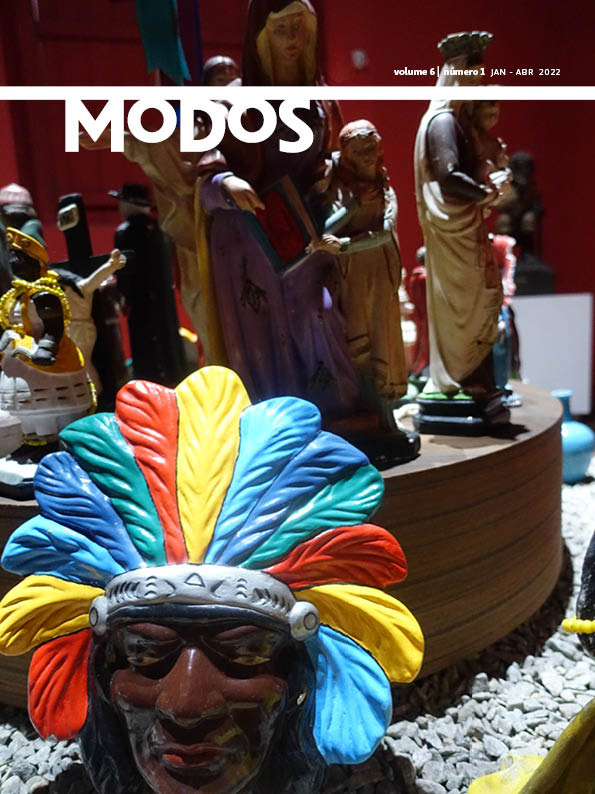Abstract
Antonio Obá (b.1983) was born and grew up in Ceilândia, a dormitory town thirty kilometres outside of Brazil’s capital, Brasilia. Though this may not seem like an especially significant biographical detail in considering Obá’s work – other writers, for example, have focused on the artist’s race and devout Catholic upbringing – I argue that this foundational fact of Obá’s upbringing and experience is more telling than first impressions suggest. This paper posits Brasilia and Ceilândia as stand-ins for a more general dynamic that structures Brazilian identity and nationhood. That violent and generative dynamic – which occurs between a range of other symbolic pairs of concepts, such as black and white, rich and poor, formal and informal, progress and stasis, sacred and profane, European and African, and so on – is Obá’s focus, thus “syncretism” emerges as an important term within his practice. The paper offers readings of two of Obá’s performances – Atos da transfiguração – desaparição ou receita de como fazer um santo (2015) and Malungo: Rite for a Black Mass (2016) – as well as an accompanying installation, Malungo (2019), as examples of the syncretic dynamic or dialectic that runs through much of Obá’s work.
References
ÁVILA, A. The Baroque Culture of Brazil. Brazil: Body and Soul, ed. SULLIVAN, E. J. New York: Solomon R. Guggenheim Museum, 2001.
BARBOSA, C. A Persisting Lack. PIPA Prize: The Window into Brazilian Contemporary Art 2017 Year 8. Rio de Janeiro: PIPA Institute, 2017.
BARROS, J. Body-Close: Transmutation of Memory and the Performativities of the Sacred in Antonio Obá. Mendes Wood DM presents Antonio Obá at Foire internationale d'art contemporain (FIAC) 2019. São Paulo: Mendes Wood DM, 2019.
BRANCHE, J. C. The Poetics and Politics of Diaspora: Transatlantic Musings. New York: Routledge, 2015.
CONDURU, R. Negros Indícios: performance, video, fotografia. São Paulo: Espaço Donas Marcianas Arte e Comunicação, 2017.
COSTA VARGAS, J. H. Black Disidentification: The 2013 Protests, Rolezinhos, and Racial Antagonism in Post-Lula Brazil. Critical Sociology, 2016, vol. 42 (4-5) 551–565.
GOSLING, David. Brasilia. Third World Planning Review (Spring 1979) 41-56.
LEE, D. Transfiguration (New Century Theology). London: Continuum, 2004.
MENDES WOOD DM, Pele de Dentro. New York: Mendes Wood DM, 2018.
MESQUITA, C. The Future’s Reverse: Dystopia and Precarity in Adirley Queirós’s Cinema. The Precarious in the Cinemas of the Americas, ed. BURUCÚA, C. and SITNISKY C. Cham, Switzerland: Springer Nature-Palgrave Macmillan, 2018.
PHILLIPS, T. Brazil's ethanol slaves: 200,000 migrant sugar cutters who prop up renewable energy boom. The Guardian, 9 March 2007. Online. Accessed 14 December 2019.
Pôr do Sol, em Ceilândia, será 1ª área do DF regularizada após lei que reduz burocracia, Globo.com, 22 October 2018. Accessed 12 December 2019.
PRESTON, J. Catholics in Brazil At Odds: Whites Resist Blacks’ African Worship. The Washington Post, 12 October 1991.
SELKA, Stephen. Black Catholicism in Brazil. Journal of Africana Religions, vol 2: 2, 2014, 287-295.
VAN DE PORT, M. Golden Storm: The Ecstasy of the Igreja de São Francisco, in Salvador da Bahia, Brazil. Religious Architecture: Anthropological Perspectives. Ed. Oskar Verkaaik. Amsterdam: Amsterdam University Press, 2013.

This work is licensed under a Creative Commons Attribution-NonCommercial-ShareAlike 4.0 International License.
Copyright (c) 2022 Nicole Smythe-Johnson

